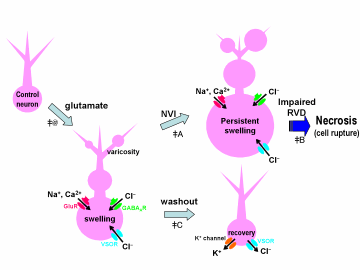Science Topics - 49
Excitotoxicity is associated with various neurodegenerative disorders, such as stroke, brain trauma and epilepsy. In the brain, during excitotoxic insults, neurons undergo rapid swelling in both the soma and dendrites. Focal swellings along the dendrites called varicosities are considered to be a hallmark of acute excitotoxic neuronal injury. However, it is not clear what pathway is involved in the neuronal anion flux that leads to the formation and resolution of excitotoxic varicosities. In the present study, we assessed the roles of the volume-sensitive outwardly rectifying (VSOR) chloride channel in excitotoxic responses in mouse cortical neurons. Whole-cell patch-clamp recordings revealed that the VSOR channel in cultured neurons was activated by NMDA exposure. Moreover, robust expression of this channel on varicosities was confirmed by on-cell and nystatin-perforated vesicle patch techniques. VSOR channel blockers abolished not only varicosity resolution after sublethal excitotoxic stimulation but also necrotic death after sustained varicosity formation induced by prolonged NMDA exposure in cortical neurons. The present slice-patch experiments demonstrated, for the first time, expression of the VSOR channels in somatosensory pyramidal neurons. NMDA-induced necrotic neuronal death in slice preparations was largely suppressed by a blocker of the VSOR channel. These results indicate that VSOR channels exert dual, reciprocal actions on neuronal excitotoxicity by serving as major anionic pathways both for varicosity recovery after washout of an excitotoxic stimulant and for persistent varicosity formation under prolonged excitotoxic insults leading to necrosis in cortical neurons.
Inoue H & Okada Y (2007) Roles of volume-sensitive chloride channel in excitotoxic neuronal injury. Journal of Neuroscience 27: 1445-1455, 2007

Schematic illustration of dual roles of the VSOR channel in mouse cortical neurons under excitotoxic conditions. VSOR is activated during excitotoxic glutamate stimulation and leads to formation of varicosities (1), and later to NVI (2) and necrotic cell death (3) by inducing NaCl influx in cooperation with GluR cation channels in both process-1 and -2 as well as with GABAAR anion channels in the process-1. VSOR is also activated after washout of glutamate and leads to resolution of varicosities (4) by inducing KCl efflux in cooperation presumably with K+ channels. GluR-mediated Ca2+ influx, which is known to be a key element of late-phase glutamate toxicity, is not included in this scheme.
*Department of Cell Physiology, National Institute for Physiological Sciences
